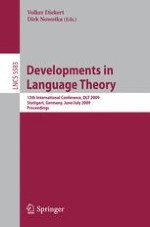2009 | Buch
Developments in Language Theory
13th International Conference, DLT 2009, Stuttgart, Germany, June 30-July 3, 2009. Proceedings
herausgegeben von: Volker Diekert, Dirk Nowotka
Verlag: Springer Berlin Heidelberg
Buchreihe : Lecture Notes in Computer Science
